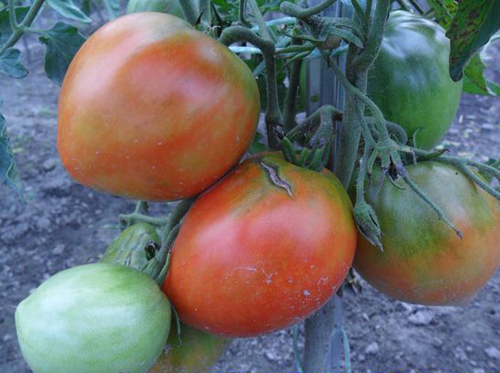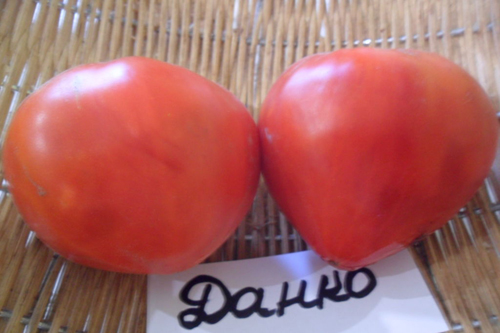Danko tomato variety
Continuing our acquaintance with domestic heart-shaped tomatoes, one cannot ignore the variety with a very “fiery” name - Danko. It is this type that many tomato growers call among the worthy and loved ones. The novelty was announced in 1998 by the Federal Research Center Institute of Cytology and Genetics of the Siberian Branch of the Russian Academy of Sciences. In 2000, the variety was entered into the State Register of Breeding Achievements of Russia with admission in all regions of the country. The variety is recommended for open ground in garden plots, small farms and household plots. In cold regions, it shows good results under film shelters. Not a hybrid.

Description
Plant of determinant type, 50 - 55 cm high in the open field. Even in greenhouses, where, by the way, the culture feels great, it does not grow higher than 80 cm. The stem and shoots of Danko are not very powerful. The branchiness is moderately pronounced, the foliage is small. The bush looks compact. Leaves are medium in size, petiolate, of the usual type, with a medium corrugated surface. The inflorescences are complex. The first fruit cluster is laid over 7 - 8 leaves, subsequent ones are formed after 1 - 2 leaves. According to reviews, on one plant, formed into 2 stems, there are no less than 30 tomatoes. And all of them, from the bottom to the top brush, are large. The peduncle is articulated.
As already mentioned, the variety belongs to large-fruited, the average mass of a tomato, according to the State Register, is 96 - 171 grams, the maximum is 300 grams. Other sources mention that individual copies of Danko can reach 400 grams and even a little more. Some gardeners, with the correct formation of the bush and the rationing of the ovary, managed to grow 800-gram specimens. The shape loved by many tomato growers is heart-shaped, slightly ribbed. When unripe, the fruit is green, with a varietal dark green spot at the stalk. A tomato that has reached the stage of consumer ripeness turns into a deep red color. The skin is thin. The pulp is very fleshy, sugary, of good density, and aromatic. Due to the high content of dry matter, very little liquid is released, so the sliced tomato does not drain in salads. There are more than 4 seed chambers, but they are small, there are few seeds. The taste is sweet. The taste of tomatoes is excellent.

Characteristics
- Danko belongs to mid-season varieties, the beginning of ripening occurs 110 - 118 days after the emergence of full shoots;
- the yield of marketable fruits, according to the State Register, is 3.4 kg per 1 square meter, which is very good for a small plant;
- the yield of mature marketable fruits is low - only 34%;
- a thin skin does not protect the fruit from cracking, especially with high soil moisture;
- in the northern regions, where at the end of summer the harvest often does not have time to ripen completely, it is customary to remove tomatoes at the stage of blanche ripeness - they are perfectly ripened at home;
- gardeners often notice that the first Danko flowers suffer from doubleness, and the fruits that have grown from them are of an ugly shape. If you notice this anomaly, just remove the flower so that the plant doesn't waste energy on the wrong tomato;
- according to reviews, the immunity of the culture is quite high, resistance to major diseases and pests is noted;
- the variety adapts perfectly to unfavorable weather conditions. It tolerates a drop in temperature, is able to grow even with insufficient illumination, is distinguished by increased drought resistance;
- the transportability and keeping quality of the fruits are low, therefore, it is advisable to immediately eat or process the harvested crop;
- the way of eating fruits is salad. But the housewives appreciated the features of the dense pulp, and now Danko is considered one of the best varieties suitable for obtaining high-quality tomato products. The pulp is thick and low-liquid, so it does not have to be evaporated for a long time to achieve the required consistency of a paste or sauce. Many people praise the resulting tomato juice.

Agrotechnics
The described tomato is usually grown in seedlings. Seeds are sown for seedlings in March, in the southern regions it is possible at the end of February. It is worth noting that the quality of purchased seeds is often complained about, and the seedlings that appear can grow frail, so the seedlings need to be provided with maximum comfort. To increase root formation, seedlings dive at the stage of 2 true leaves. When the Danko bushes are 60 - 65 days old, they are ready to be transplanted to a permanent place. Due to the compactness of the variety, the planting pattern can be somewhat compacted - 25 - 30 cm between bushes, 40 - 45 cm row spacing. 7 - 8 plants can be placed on one square meter of the plot, which will significantly increase the yield level and save space on the garden bed. The way the bush is formed can affect the weight of the fruit. If you lead in 1 stem, then the harvest will turn out to be quite large-fruited. But many gardeners prefer to form a plant in 2 - 3 stems and are also satisfied with the result. It is advisable to tie up a tomato, especially if it grows indoors. Patching is carried out as excess shoots grow. Watering should be infrequent, but abundant. Top dressing is carried out with universal fertilizers, which can be alternated with organic matter.
Many tomato growers consider Danko to be a very reliable variety. Tomatoes have an excellent presentation and excellent taste, suitable for natural consumption and for processing. Resistance to adverse conditions and diseases allows you to grow a crop not only indoors, but also outdoors in cold regions. In order to grow your favorite variety next year, you no longer need to buy seed. It is enough to choose the most beautiful fruit and collect seeds from it. Disadvantages in the form of cracking of the skin of tomatoes can be avoided by adhering to the correct agricultural technology.








